Hedges
I See Electromagnetic Fields!
- Joined
- Mar 28, 2020
- Messages
- 20,682
So you think you can backfeed a transformer secondary, either as step-up or as auto-transformer?
Turns out these things aren't so ideal and reversible as one might expect. It isn't just the greater inrush (primary is often wound outside secondary to reduce inrush current), but also idle current is much higher driving secondary.
My attempt to use a 3-phase 480 to 120/208Y transformer for step-up didn't go well.

 diysolarforum.com
diysolarforum.com
I've now picked up a 25 kVA 240/480V to 120/240V transformer. I plan to use it for isolation, 240V in to 120/240V out with derived neutral (which will be grounded.)
This sort of transformer is quite common, and could serve as auto-transformer for people who need to get a neutral for middle of 220V inverter, or split-phase from a 120V inverter.

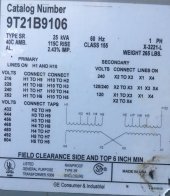
The obvious way to use it is with the two 120V windings connected in series. I fed 120V (125V, actually) into one winding and the other did produce 125V as well, and 250V across the two. Output voltage would drop a couple percent under load, maybe 5% if 12.5 kVA being transferred.
It was making noise under no-load. Clamp ammeter showed 10A (1250 VA apparent power).
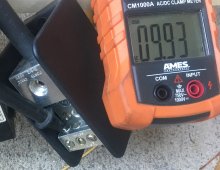
Scope, calculating V x I and averaging, showed 263 W consumed (and 9 A rms.)
Notice in particular the severe peak in current (upper trace C3) as the winding is driven into saturation. At its normal operating voltage, but backfed.
Voltage shown in lower trace C1, power middle trace M1.
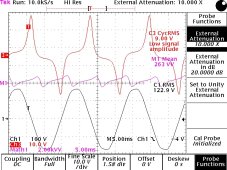
By instead feeding 120V into one of the 240V primary windings, connected in series, performance was much nicer.
Only 0.36A drawn, 45W apparent power. Voltage on second winding was still same 125V as applied.
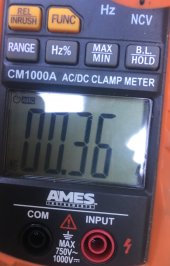
Scope shows 0.617 A RMS, and 57 W dissipated. (More real than apparent power? Perhaps measurement error or drift over time?)
Since this configuration is applying 120V to one of two 240V windings (which are intended to carry about 50A each), expect only 6 kW to be available on second winding.
Note the current waveform isn't nearly as ugly as when secondary was back driven, although still not a nice sine wave.
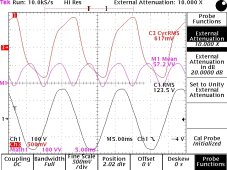
Makes me wonder how the transformer would behave if excited by voltage on primary, but power delivered from GT PV inverter on secondary.
I'm still learning about transformers.
Turns out these things aren't so ideal and reversible as one might expect. It isn't just the greater inrush (primary is often wound outside secondary to reduce inrush current), but also idle current is much higher driving secondary.
My attempt to use a 3-phase 480 to 120/208Y transformer for step-up didn't go well.

3-Phase SMA Sunny Island (15kW) + Sunny TriPower (30kW)
Showing a work-in-progress assembling 3-phase SMA system. 3x SI-5048-US are configured for 3-phase and produce 120/208Y, rated 15 kW continuous. Sunny TriPower 30000TL-US-10 is 480V delta (or 277/480Y), rated 30 kW. TriPower combiner box will be used, but for now just one string being connected...
I've now picked up a 25 kVA 240/480V to 120/240V transformer. I plan to use it for isolation, 240V in to 120/240V out with derived neutral (which will be grounded.)
This sort of transformer is quite common, and could serve as auto-transformer for people who need to get a neutral for middle of 220V inverter, or split-phase from a 120V inverter.


The obvious way to use it is with the two 120V windings connected in series. I fed 120V (125V, actually) into one winding and the other did produce 125V as well, and 250V across the two. Output voltage would drop a couple percent under load, maybe 5% if 12.5 kVA being transferred.
It was making noise under no-load. Clamp ammeter showed 10A (1250 VA apparent power).

Scope, calculating V x I and averaging, showed 263 W consumed (and 9 A rms.)
Notice in particular the severe peak in current (upper trace C3) as the winding is driven into saturation. At its normal operating voltage, but backfed.
Voltage shown in lower trace C1, power middle trace M1.

By instead feeding 120V into one of the 240V primary windings, connected in series, performance was much nicer.
Only 0.36A drawn, 45W apparent power. Voltage on second winding was still same 125V as applied.

Scope shows 0.617 A RMS, and 57 W dissipated. (More real than apparent power? Perhaps measurement error or drift over time?)
Since this configuration is applying 120V to one of two 240V windings (which are intended to carry about 50A each), expect only 6 kW to be available on second winding.
Note the current waveform isn't nearly as ugly as when secondary was back driven, although still not a nice sine wave.

Makes me wonder how the transformer would behave if excited by voltage on primary, but power delivered from GT PV inverter on secondary.
I'm still learning about transformers.
Last edited:



